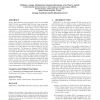Free Online Productivity Tools
i2Speak
i2Symbol
i2OCR
iTex2Img
iWeb2Print
iWeb2Shot
i2Type
iPdf2Split
iPdf2Merge
i2Bopomofo
i2Arabic
i2Style
i2Image
i2PDF
iLatex2Rtf
Sci2ools
MSWIM
2004
ACM
2004
ACM
IEEE 802.11 rate adaptation: a practical approach
Today, three different physical (PHY) layers for the IEEE 802.11 WLAN are available (802.11a/b/g); they all provide multi-rate capabilities. To achieve a high performance under varying conditions, these devices need to adapt their transmission rate dynamically. While this rate adaptation algorithm is a critical component of their performance, only very few algorithms such as Auto Rate Fallback (ARF) or Receiver Based Auto Rate (RBAR) have been published and the implementation challenges associated with these mechanisms have never been publicly discussed. In this paper, we first present the important characteristics of the 802.11 systems that must be taken into account when such algorithms are designed. Specifically, we emphasize the contrast between low latency and high latency systems, and we give examples of actual chipsets that fall in either of the different categories. We propose an Adaptive ARF (AARF) algorithm for low latency systems that improves upon ARF to provide both sh...
| Added | 30 Jun 2010 |
| Updated | 30 Jun 2010 |
| Type | Conference |
| Year | 2004 |
| Where | MSWIM |
| Authors | Mathieu Lacage, Mohammad Hossein Manshaei, Thierry Turletti |
Comments (0)

